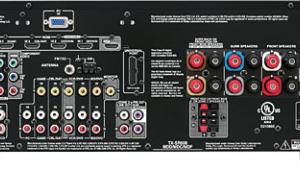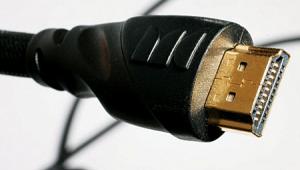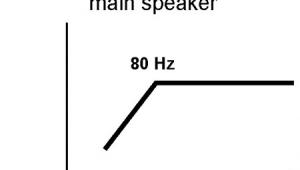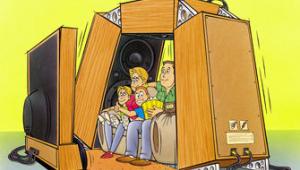Surround Revisited
Have you ever heard wine lovers obsess about the bottle? Of course not. True oenophiles care most about what's in the bottle. There, in a nutshell, you have what's most peculiar about the high-definition-DVD format race. All we hear about is the vessel. What about the contents?

The good news is that, regardless of how the format race shakes out, we know what tricks the next generation of high-rez discs will perform, because the standards in video and audio aren't set by Toshiba or Sony. The real players are the Moving Picture Experts Group (MPEG), Dolby Laboratories, and DTS. They're in charge of the video and audio compression codecs that will give the Blu-ray Disc (BD) and HD-DVD a flavor that goes well with chicken, fish, and action movies.
Like BD and HD-DVD, Dolby TrueHD and DTS-HD Master Audio are determined lunges for licensing revenue. However, building two audio-codec families into the new format (oops, formats) has proven to be a lot easier than settling on a physical disc structure. Here's how the next wave in surround sound will affect the bits that seduce your ears.
Dolby TrueHD and Dolby Digital Plus
Star Wars (1977), which used the Dolby Surround format, is often cited as the first movie since Disney's Fantasia (1940) to use surround sound. However, Dolby Surround had already been used in such non-blockbusters as Lizstomania (1975) and the remake of A Star Is Born (1976). The format's successor, Dolby SR (Spectral Recording), is still the standard for analog soundtracks on 35mm film prints, while digital film soundtracks use Dolby Digital.
The Dolby Surround signal format drove the growth of surround in the home with Dolby Pro Logic, which uses matrixing to derive front-center and rear-surround signals from the front left and right channels. Dolby Pro Logic II is the latest version, while Dolby Pro Logic IIx expands matrixed surround to 7.1 channels.
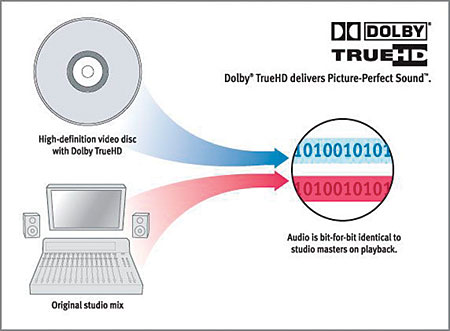
Dolby moved beyond the matrixing trick to develop a new format that delivered each channel discretely using what is commonly called "compression," although "data reduction" might be more precise. Originally called AC-3, now Dolby Digital, that format is officially mandated in both the federally sanctioned DTV standard and the DVD Consortium's specs for the existing standard-definition DVD-Video format. Its 6.1-channel version, codeveloped with THX, is Dolby EX.
Dolby Digital Plus is billed as an extension to Dolby Digital. For backwards compatibility with the Dolby Digital equipment in 30 million surround receivers and 60 million set-top boxes, Dolby Digital Plus signals are converted to Dolby Digital at the relatively high data rate of 640 kilobits per second (Dolby Digital usually operates at 192 to 448 kbps) through S/PDIF outputs, better known as digital optical and coaxial. Dolby Digital Plus will travel first class via the new HDMI interface.
To reduce audible artifacts, Dolby Digital Plus uses a few fancy new tricks, which focus on specific flaws that become more perceptible as the bit stream narrows. High-frequency elements present in more than one channel benefit from more efficient "channel coupling." Highs also benefit from "spectral extension," which focuses on metadata specifically related to high-frequency synthesis.
Fleeting transient elements, including percussive thumps, benefit from "transient prenoise processing." Continuous tones, so often ragged-sounding in lossy formats, get the additional clarifying data they need by triggering a special filter that provides further improvements in high-frequency and transient response. Dolby gives this the catchy name of "adaptive hybrid transform processing."
Unlike previous audio codecs, Dolby TrueHD is a lossless format, meaning there is no "data reduction" as with the original Dolby Digital. At its core is MLP Lossless, the same high-rez technology that animates DVD-Audio. With the vastly superior transfer rate that both BD and HD-DVD will have to offer (up to 24 megabits per second on BD), Dolby TrueHD is able to deliver sampling frequencies from 48 to 192 kilohertz and 16- to 24-bit data strings. (Consider that a CD's sampling frequency is 44.1 kHz and uses a 16-bit string.) Since Dolby TrueHD decoders can decode a two-, six-, or eight-channel playback, audiophiles' dreams for high-rez sound is slowly becoming a reality.
The HD-DVD format specifications mandate the use of Dolby TrueHD and Dolby Digital Plus. BD specs require the original Dolby Digital and allow Dolby TrueHD and Dolby Digital Plus as an option. Either way, your new high-def DVD player—in whatever format—will mesh with your existing surround receiver or preamp/processor.
DTS-HD Master Audio
Jurassic Park (1993) was to DTS what Star Wars was to Dolby—a milestone marking the company's entrance into cinematic surround sound. Terry Beard is DTS's Ray Dolby. He founded the company on a shoestring in 1990 and later got funding from Universal Studios, Steven Spielberg, and others. DTS is now one of several surround standards in theatrical exhibition along with Dolby Digital, Dolby SR, and Sony Dynamic Digital Sound. Until recently, the company's official name was Digital Theater Systems; now it's officially just DTS.
The DTS codec for home surround is named DTS Coherent Acoustics—although, again, on spec sheets it's just DTS. On paper, at least, it supports up to 2,048 channels (that's not a typo!) at resolutions beyond 192 kHz.
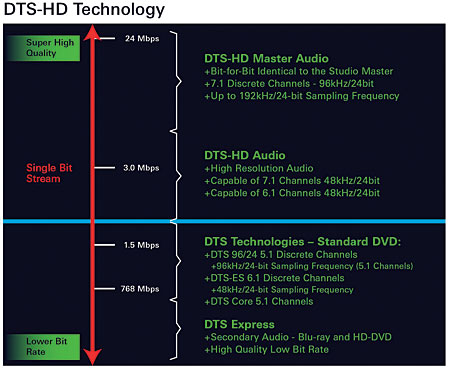
After a brief vogue in DTS-encoded CDs, DTS rode into home theater systems on the coattails of the DVD-Video format, despite the fact that the DVD Consortium originally specified eight channels of Dolby AC-3 and no DTS. But the DTS people lobbied hard to get their codec supported, first by high-end pre/pros, then by receivers and DVD players.
DTS-HD is the latest wrinkle in DTS branding. Not so much an extension as a consolidation, it includes all the Coherent Acoustics formats—DTS, DTS ES Discrete, DTS ES Matrix, DTS Neo:6, and DTS 96/24—plus a new lossless format that supports up to 7.1 channels and a sampling frequency of 192 kHz. That's more than four times that of the CD format. DTS-HD was initially known as DTS++ (although the term didn't spread far beyond the company's engineers).
The 5.1 configuration of DTS first made inroads into DVD's Dolby Digital–sanctioned territory by offering consumers a higher data rate and, according to the DTS people, audibly smoother sound. Dolby, of course, hotly disputes this, and the two companies have traded shots in various white papers memorable mainly for their amusingly polemical tone.
DTS ES Discrete was a major coup—it was the first 6.1-channel surround format to encode the rear-surround channel discretely, without depending on the fakery of matrixing. DTS ES Matrix derives the rear-surround with matrixing, as does Dolby EX.
For stereo sources, DTS offers DTS Neo:6 as an alternative to DPLII/IIx. It adapts a two-channel signal to 6.1 channels.
DTS 96/24 is something of a paradox. It's a lossy format, but one that encodes sound in strings of 24 zeros and ones and with a sampling frequency of 96 kHz. Oh, and it's a surround format. You'll find it nesting in some DVD-Audio and DVD-Video titles as the alternate soundtrack (in lieu of Dolby Digital). That's the cool thing about the DVD-Audio format: The lossy alternate track gives you a good taste of what the lossless track sounds like. Too bad the format isn't more popular.
The PC gets the DTS treatment in DTS Connect. It includes DTS Interactive, which encodes all audio into a 1.5-Mbps bit stream that travels via S/PDIF digital output to any DTS-enabled surround system. For stereo content—whether it's MP3, WMA, or uncompressed CD—there's DTS Neo:6. PC-delivered DTS can be either software- or hardware-based (built into a card). DTS also has a presence in gaming via PlayStation2.
BD and HD-DVD both mandate the original DTS we've come to know and love on standard-definition DVDs. The other elements of the DTS-HD package are optional but tantalizing.
The Audiophile Toast?
The Blu-ray disc and (to an only slightly lesser extent) HD-DVD are pretty fat balloon glasses. So, there's also room for lossless and uncompressed surround to swish around with the lossy formats.
Blu-ray Disc requires 7.1-channel 96-kHz/24-bit PCM and allows 5.1-channel 192/24 PCM. The acronym stands for pulse code modulation, and it's a much expanded version of the same digital language used in the Compact Disc.
Wouldn't it be ironic if BD and HD-DVD succeeded where DVD-Audio and SACD failed—putting high-rez surround on every rack? Audiophiles would drink to that.
- Log in or register to post comments
